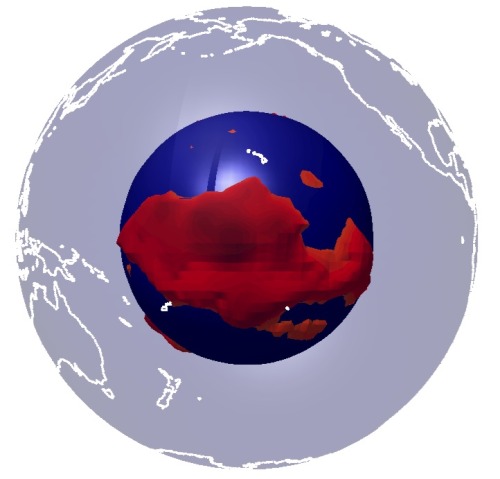Hidden in the deep.Deep beneath Africa and the Pacific Ocean sits…something intriguing. We’ve never
Hidden in the deep.Deep beneath Africa and the Pacific Ocean sits…something intriguing. We’ve never sampled it directly as far as we know, but seismic techniques show that there’s something odd in the mantle at these sites. Something that may well have shaped the development of our planet as we know it today.If an earthquake is large enough, it will release energy in the form of seismic waves that can be detected even after the waves travel through the entire planet. These waves can be used to illustrate properties of the materials they travel through; if there’s a boundary they can bounce off it, if there’s a change in chemistry or temperature they can slow down or speed up. Measuring how long it takes for a seismic wave to get from the source of an Earthquake to a detector on the opposite side of the Earth thus gives scientists a way to probe Earth’s internal structure.Turning measurements of individual earthquakes into a full 3-D picture of the planet’s interior is a time-consuming, computationally demanding job, so it took until recent decades for scientists to really use these waves to look for variations in the planet hidden within the lower mantle. When they finally were able to do so, two features stood out.Seismic waves that travel through the mantle deep beneath Africa and beneath the Western Pacific Ocean slow down. These areas aren’t small features – they’re over 1000 kilometers high (over 1/3 the height of the mantle) and the size of continents, and when waves enter them they slow down consistently. Their outlines are shown in these rough images – the slow areas are the red zones as is typical for how seismic data is displayed (the dark blue is the outer core).This slowing of some types of seismic waves gives these features their technical name, “LLSVP” or “Large, Low-Shear-Velocity Provinces”. That’s enough of a mouthful for scientists that they’ve been given other nicknames – some have called them superplumes, thermochemical piles, or superswells, but since we don’t know exactly what they are it’s hard to apply any of those terms. The techniques show they’re present, but small structures and even what the edges look like are problems that seismic waves have a tough time answering without a lot more data.Slow seismic velocities in the mantle generally are associated with warmer temperatures, but not always – chemistry can play a role as well. The names superplume or superswell come from assuming these spots have slow seismic velocities because they’re warm. These superplumes could be piles of hot material formed at the bottom of the mantle that are gradually trying to move upwards.Alternatively, they could be chemically distinct from the rest of the mantle. If they were denser than the rest of the mantle (say, from having more iron, a particularly high-mass element in the mantle), they could be stable over long time periods and even last over a billion years. The Earth has processes that can create piles of dense stuff – subduction zones send dense material downward, towards the boundary between the core and the mantle, and a pile of old, subducted slabs could fit the measured seismic signatures as well.Since we don’t know exactly what these provinces are, we also don’t know what they can do, but there are ideas. One of them sits directly under Africa and, if it is hot, that object could be sending up plumes of hot material that keep running into Africa and tearing it apart. The East African Rift Zone has likely interacted with a plume of hot material from the mantle that has contributed to pushing the plate apart, and the opening of the south Atlantic Ocean also coincides with the eruption of plume lavas that could have come from this site as well. A super-plume sitting in the mantle could be shooting these plumes of warm material upward, and in the process implicated in the breakup of Pangaea.Similarly, the site in the Pacific sits below an area filled with volcanic islands. Plumes of hot material coming from the LLSVP could be contributing to these islands as well. Some scientists even think the Pacific structure could contribute to the Hawaiian hot spot, but linking Hawaii directly to the LLSVP is difficult since Hawaii isn’t above the area where its been detected.Other scientists have suggested different ways these features could interact with the surface. One recent paper argued that both mantle plumes, as noted above, and kimberlite eruptions, which are sudden, violent eruptions that originate hundreds of kilometers deep within the mantle, have been correlated with these sites for several hundred million years. However, that’s a difficult case to make since plates are able to move on the Earth’s surface and we don’t know exactly how these features would generate either of those eruption types.These structures have been the focus of decades of research already and will likely remain intriguing to geoscientists for decades to come. Anyway, if you’re ever in Africa or the Western Pacific, take a second, look down, and remember something super sits below you.-JBBImage credits:https://commons.wikimedia.org/wiki/File:Cartoon_of_Pacific_LLSVP.jpghttps://commons.wikimedia.org/wiki/File:Cartoon_of_African_LLSVP.jpgRead more:http://adsabs.harvard.edu/abs/2011AGUFMDI22A..07Zhttp://www.nature.com/ngeo/journal/v4/n12/full/ngeo1328.html http://onlinelibrary.wiley.com/doi/10.1029/2011GC003808/fullhttp://www.nature.com/nature/journal/v466/n7304/full/nature09216.html -- source link
#science#mantle#llsvp#superplume#superswell#geology#geophysics#research#subduction#plate tectonics#africa#pacific#kimberlite

